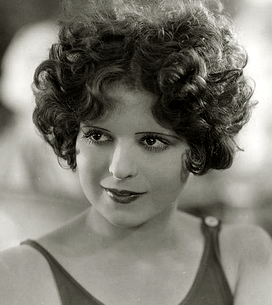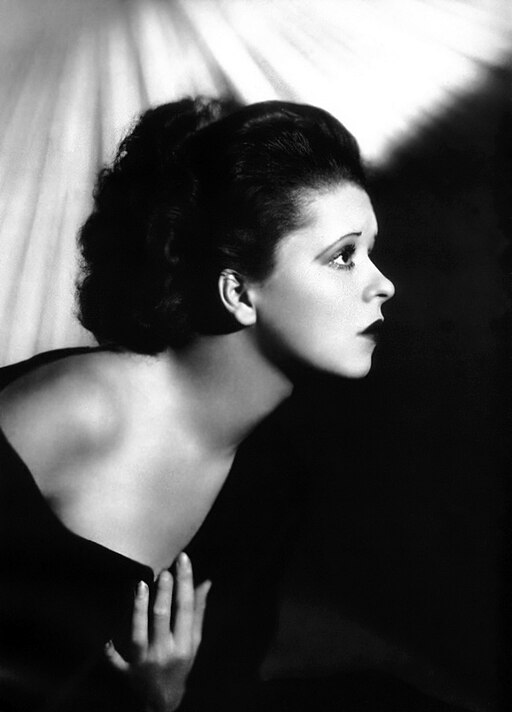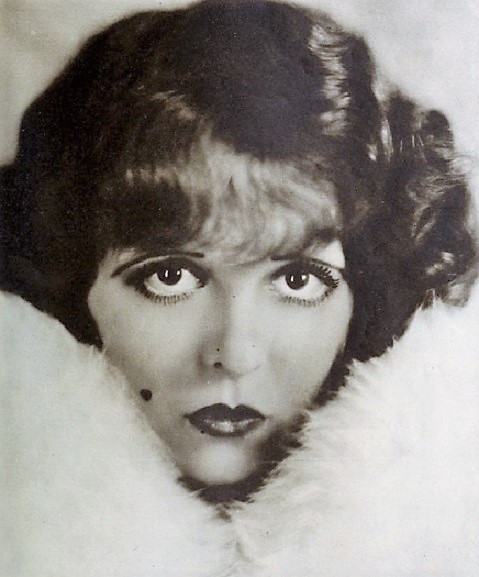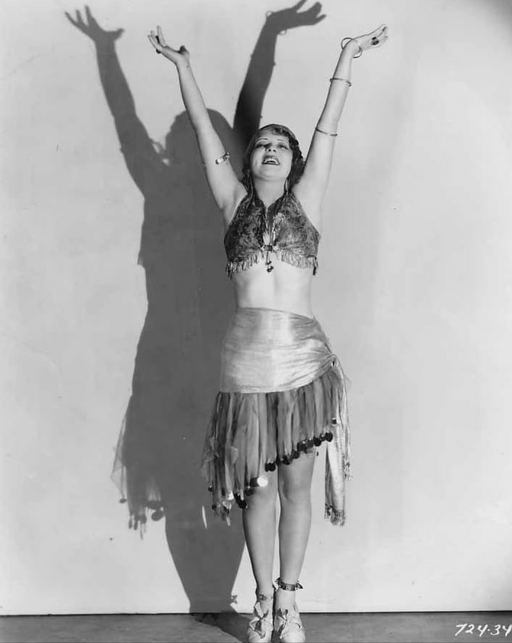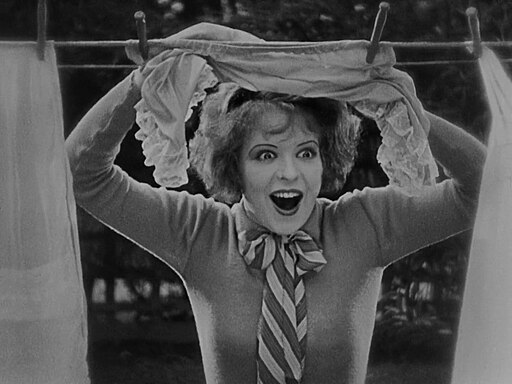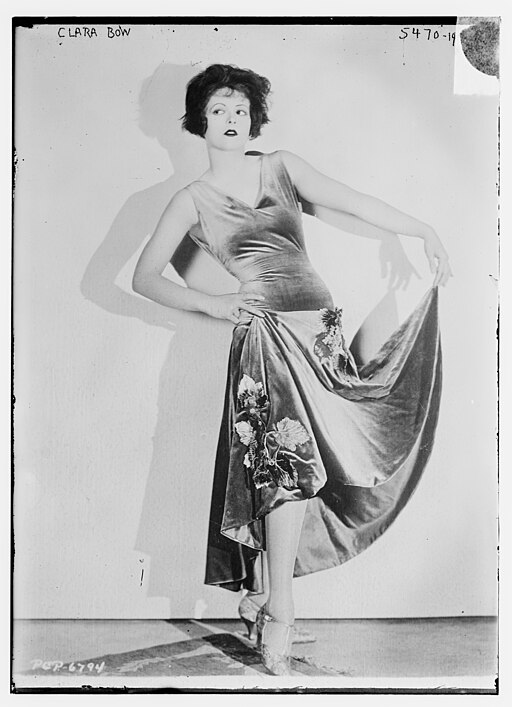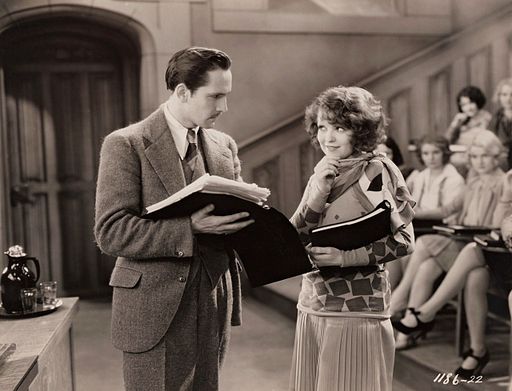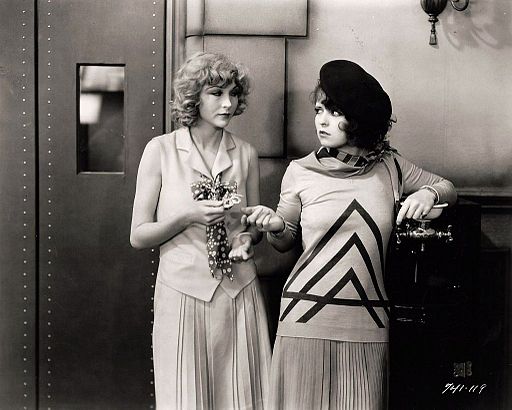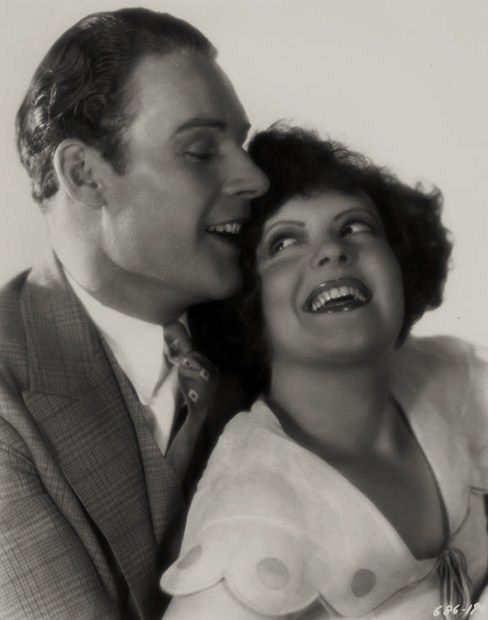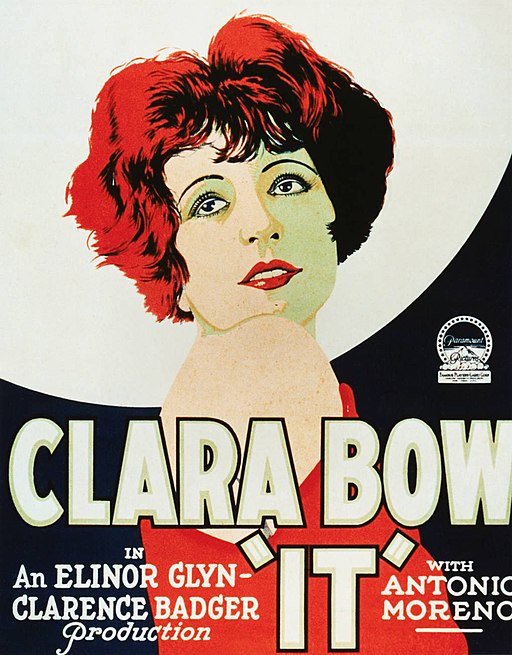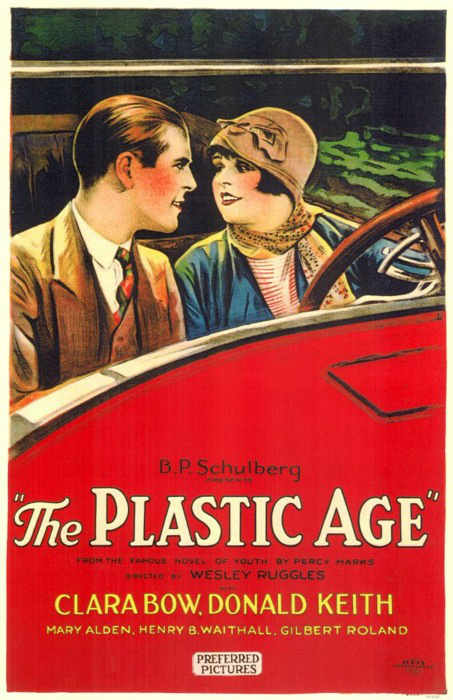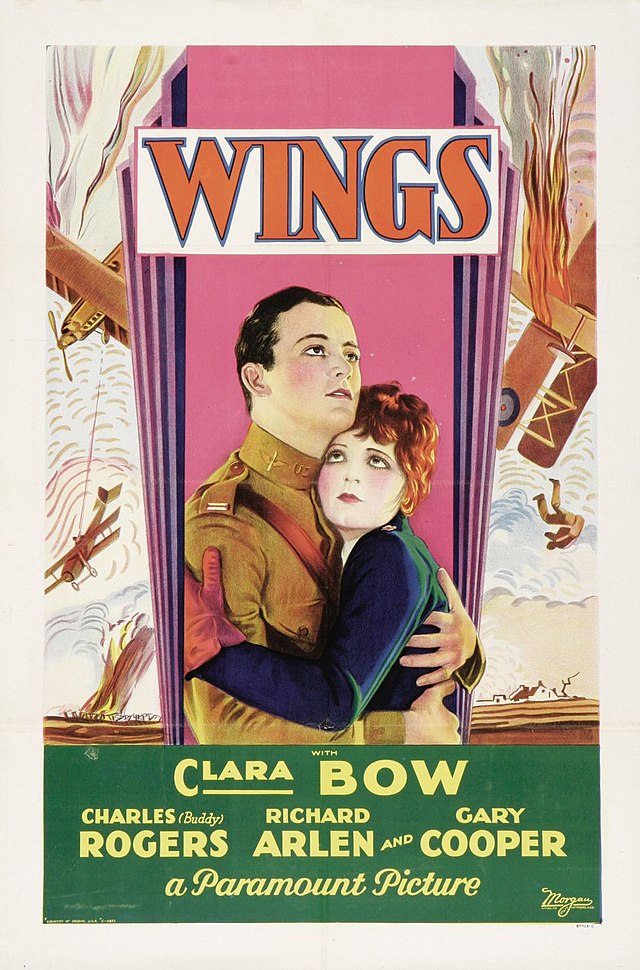Clara Bow
back| Full Name | Clara Gordon Bow |
| Stage Name | Clara Bow |
| Born | July 29, 1905 |
| Birthplace | Brooklyn, New York City, U.S. |
| Died | September 27, 1965 |
| Buried | Forest Lawn Memorial Park, Glendale, California, U.S. |
| Married to | Rex Bell (real name George Francis Beldam), a cowboy actor and later a politician. They married in 1931. |
| Children | Tony Beldam (later changed to Rex Anthony Bell Jr.) and George Beldam, Jr. |
| Notable films | It (1927) - Wings (1927) - The Wild Party (1929) - Mantrap (1926) |
Clara Bow
The “It Girl”
Clara Bow, born in Brooklyn in 1905, rose from poverty to become the quintessential "It Girl" of the Roaring Twenties. Her breakthrough role in "It" (1927) captured the essence of the era's flapper, making her a symbol of youthful rebellion and sexual liberation.
Bow's vibrant on-screen presence and natural acting style made her one of silent cinema's most endearing stars, with significant films like "Wings" (1927) underlining her versatility.
Despite her immense popularity, Clara faced personal challenges, including mental health struggles and the transition to sound films, which eventually led to her retirement in 1933.
Related
Clara Bow (1905 – 1965)
Biography and Career Overview
Clara Gordon Bow, born on July 29, 1905, in Brooklyn, New York, emerged from humble beginnings to become one of the most iconic actresses of the silent film era, celebrated as "The It Girl." Her life, marked by dazzling heights and profound challenges, embodies the quintessential story of early Hollywood glamour mixed with personal struggles.
Early Years
Clara's childhood was steeped in poverty and hardship in the tenements of Brooklyn. Her father, Robert Bow, was often absent and struggled with employment, while her mother, Sarah Gordon Bow, battled with mental health issues, casting a shadow over Clara's early life. Despite these challenges, Clara found solace and escape in the burgeoning world of movies, dreaming of a brighter future on the silver screen.
Her break into the film industry came in the early 1920s after winning a magazine's acting contest, which promised a part in a movie. Although the role was small and the film obscure, it provided the ambitious Clara with the foothold she needed to pursue her dreams in Hollywood.
Path to Success
Clara's magnetic presence and natural acting talent quickly caught the attention of audiences and filmmakers alike. Her breakout role in "Down to the Sea in Ships" (1922) showcased her charisma, setting the stage for her rise to stardom. However, it was her performance in "It" (1927) that catapulted her to international fame, giving birth to the term "The It Girl." Clara Bow became synonymous with the carefree, spirited flapper of the 1920s, embodying the era's newfound freedom and rebelliousness.
Personal Life and Marriages
Despite her professional success, Clara's personal life was tumultuous. She faced relentless scrutiny and sensationalism from the press, which took a toll on her mental and emotional well-being. In 1931, seeking stability, Clara married actor Rex Bell (George Francis Beldam), with whom she had two sons, Rex Anthony Bell Jr. and George Beldam Jr. The marriage offered her a respite from the spotlight, and she gradually retreated from Hollywood to focus on her family.
Passions and Interests
Beyond her film career, Clara was passionate about helping those in need, often donating to charities and assisting struggling actors and actresses. Her empathy likely stemmed from her own difficult upbringing, making her sensitive to the struggles of others. Despite her fame, she remained grounded, finding joy in simple pleasures and the comfort of her family.
Death and Legacy
Clara Bow's later years were marked by health issues, including a heart attack in 1949 and bouts of mental illness, which led to her hospitalization. She passed away from a heart attack on September 27, 1965, in Los Angeles, California, leaving behind a complex legacy that encompasses both her groundbreaking career and her personal battles.
Clara Bow remains a symbol of the Roaring Twenties and the silent film era's exuberance. Her naturalistic acting style, which contrasted sharply with the exaggerated expressions common at the time, paved the way for future generations of screen actors. Despite the controversies and challenges she faced, Clara Bow's contributions to cinema and her status as a cultural icon endure, celebrating her indomitable spirit and unforgettable presence on the silver screen.
Clara Bow: The First It Girl:
Notable Movies Starring Clara Bow:
1922
"Beyond the Rainbow": Initially cut from the final release, Bow was later reinstated due to public demand; the film explores themes of deceit and love.
1923
"Down to the Sea in Ships": In this silent drama, Bow plays a tomboyish character in a story centered around whaling and a young man's quest to prove himself to his father.
1924
"Black Oxen": Bow plays a flapper who injects vitality into the life of a woman rejuvenated by a scientific experiment.
1925
"The Plastic Age": Portraying a college student navigating love and societal expectations, this film solidified Bow's image as a flapper icon.
1926
"Mantrap": Clara stars as a vivacious manicurist who, after marrying a Canadian woodsman, finds herself in a love triangle with a New York lawyer. This film is noted for its comedic elements and Bow's charismatic performance.
1927
"It": The film that coined Bow as "The It Girl," she plays a shop girl who has her sights set on her wealthy boss. The film explores the concept of "It," a magnetic appeal.
"Wings": A landmark in film history and the first Academy Award winner for Best Picture, Bow plays a supporting role in this World War I epic centered on fighter pilots.
1928
"The Fleet's In": Clara portrays a young woman caught in a love triangle, showcasing her ability to blend comedy with romantic drama.
1929
"The Wild Party": As Bow's first talkie, she plays a college girl who becomes involved with a professor, navigating the challenges of a scandalous relationship.
1930
"Love Among the Millionaires": Bow plays a waitress who falls in love with a wealthy playboy, only to find out he's not as rich as she thought.
1931
"Call Her Savage": Clara delivers a powerful performance as a fiery Texas heiress who experiences the highs and lows of love, from passionate romances to heartbreaking betrayals.
1932
"Red Hair": In one of her final films, Bow plays a fiery redhead who captures the attention of several suitors, embodying the spirited flapper to the end. Unfortunately, no complete print of this film survives today.
1933
"Hoop-La": Clara's final film before retiring from Hollywood, she plays a carnival cooch dancer who catches the eye of a naive farmer, showcasing her enduring charm and talent.
Clara Bow as Inspiration for Betty Boop:
Clara Bow and Betty Boop, the animated cartoon character created by Max Fleischer, share a significant connection rooted in the cultural zeitgeist of the 1920s and early 1930s. Betty Boop, first appearing in 1930, was heavily inspired by the flapper persona, with Clara Bow being the quintessential real-life embodiment of this archetype. The connection between Bow and Betty Boop is primarily stylistic and symbolic, highlighting how Bow's image influenced the creation and characterization of Betty Boop.
Visual Similarities
Betty Boop's physical appearance, including her short hair, expressive eyes, and flirtatious demeanor, mirrors the flapper style that Clara Bow popularized on the silver screen. Bow's iconic look and spirited personality were emblematic of the flapper movement, making her a natural model for Betty Boop's character design.
Personality Traits
Both Clara Bow and Betty Boop are celebrated for their vivacity, independence, and sexual confidence, traits that were groundbreaking at the time. Betty Boop's character often displayed a playful and rebellious spirit, echoing Bow's on-screen personas and her off-screen reputation as a free-spirited icon of modern femininity.
Cultural Impact
Clara Bow's influence on Betty Boop reflects the broader cultural impact of Bow's persona. As "The It Girl," Bow embodied the modern woman of her era, challenging traditional norms and representing a new, more liberated identity for women. Betty Boop, as an animated character, continued this representation in a more fantastical medium, becoming a symbol of the flapper's enduring appeal and influence in popular culture.
Analysis of the Acting Style of Clara Bow:
Clara Bow's style was characterized by a naturalism and vibrancy that stood in stark contrast to the more theatrical and exaggerated mannerisms that were common among actors of her time. This section provides a detailed analysis of her unique approach to acting, highlighting the qualities that set her apart and endeared her to audiences.
Expressiveness and Emotional Depth
Bow was renowned for her expressive face and eyes, which she used to convey a wide range of emotions without the need for dialogue. In a time when intertitles were used to communicate spoken words, Bow's ability to express thoughts and feelings through subtle gestures and facial expressions allowed audiences to connect with her characters on a deeper level. Her smile could light up the screen, while her eyes could convey complex emotions such as longing, mischief, or sorrow, making her performances feel authentic and relatable.
Naturalism
One of the hallmarks of Bow's acting was her naturalism. Unlike many of her contemporaries who relied on the theatrical acting styles of the stage, Bow's performances were grounded in realism. She brought a sense of spontaneity and genuineness to her roles, whether she was playing a flirty flapper or a determined working-class heroine. This naturalistic approach made her characters seem more like real people than caricatures, which was revolutionary at the time and contributed to her immense popularity.
Physicality and Energy
Bow's physicality was another distinctive aspect of her acting style. She was known for her dynamic energy and movement, often using her entire body to express her characters' emotions and intentions. Whether dancing in a lively flapper sequence or engaging in slapstick comedy, Bow's physical vigor and expressiveness added an extra layer of engagement to her performances. Her vivacity and charm were infectious, capturing the spirit of the Roaring Twenties.
Versatility
While often celebrated for her roles as the quintessential flapper, Bow's acting range extended far beyond this archetype. She displayed considerable versatility, adeptly handling drama, comedy, and romance. Her filmography showcases a variety of roles, from comedic turns in films like "It" and "Mantrap" to more dramatic roles in movies such as "Down to the Sea in Ships" and "Call Her Savage." This versatility demonstrated her ability to delve into different emotional territories and character types, showcasing her depth as an actress.
Legacy and Influence
Clara Bow's acting style had a lasting impact on the film industry, setting new standards for screen acting that emphasized naturalism and emotional authenticity. Her performances helped pave the way for future generations of actors, influencing how emotions and stories were conveyed on screen. Even after the transition to sound films, the legacy of her expressive and naturalistic approach continued to resonate, influencing the development of film acting techniques in the sound era.
In conclusion, Clara Bow's acting style was revolutionary for its time, characterized by a blend of expressiveness, naturalism, and vitality. She brought a new dimension to screen acting, capturing the hearts of audiences and leaving an indelible mark on the history of cinema. Her legacy endures, not only as a symbol of the Roaring Twenties but also as a pioneer who reshaped the art of film acting.
Memorable Quotes:
On Fame and Happiness:
- "I don't know why people like me. They just do. That's the thing I'm most curious about. I don't know what it is. I wish I did for my own peace of mind."
- "The more I see of men, the more I like dogs."
On Her Career and Acting:
- "I hate talkies. They're stiff and limiting. You have to be so careful about your voice, and you can't get any personality into the part you're acting."
- "They yell at me to be dignified. But what are the dignified people like? The people who are held up as examples for me? They are snobs. Frightful snobs... I'm a curiosity in Hollywood. I'm a big freak, because I'm myself!"
Reflecting on Personal Struggles:
- "I never had any friends later on like the ones I had when I was 12. Jesus, does anyone?"
Significance of her Performance in “It”:
Clara Bow's performance in the 1927 film "It" stands as a pivotal moment in her career, marking her transformation from a popular actress to an enduring icon of the silent film era and the epitome of the "flapper" image that defined the Roaring Twenties. The film, and her role in it, had a significant impact on her career for several reasons:
Defining the "It Girl"
The concept of "It," as presented in the film, refers to a certain magnetic appeal or charismatic energy that one possesses naturally, an indefinable quality that makes someone compelling and attractive without relying on traditional notions of beauty. Bow's character, Betty Lou Spence, epitomizes this trait with her vivacious personality, independence, and allure. Bow's performance was so aligned with the concept that she herself became synonymous with "It," earning the nickname "The It Girl." This branding was instrumental in shaping her public persona and cemented her status as a cultural icon of the era.
Box Office Success
"It" was a tremendous commercial success, not only in the United States but internationally, affirming Clara Bow's status as a box office draw. Her portrayal of a spirited shop girl who pursues her wealthy employer with charm and wit resonated with audiences, showcasing Bow's ability to carry a film with her charismatic screen presence. This success solidified her position as one of the leading actresses of the silent film era and a key figure at Paramount Pictures, her home studio.
Influence on Popular Culture
Clara Bow's performance in "It" had a lasting impact on popular culture, influencing fashion, behavior, and attitudes toward women's independence and sexuality. Bow's portrayal of Betty Lou Spence as a confident, self-reliant woman who pursued her desires on her own terms challenged traditional gender roles and became a model for the modern woman of the 1920s. Her character's style, demeanor, and independence reflected and amplified the flapper phenomenon, making Bow an emblem of the era's progressive attitudes towards femininity and freedom.
Transition to Sound Films
While "It" was a silent film, its success helped ease Bow's transition into talking pictures. Although she expressed personal reservations about the advent of sound in cinema, fearing it might diminish her natural spontaneity and expressiveness, the popularity she garnered from "It" and other silent films provided her with a solid foundation from which to navigate the early sound era of Hollywood.
Legacy
The film's success and Bow's performance had a lasting effect on her legacy, ensuring her place in cinematic history. Even decades after her retirement and the end of the silent film era, Clara Bow continues to be remembered and celebrated for her role in "It." The film is not only a highlight of her career but also a significant cultural artifact, representing the zeitgeist of the 1920s and the transformative power of cinema.
Awards and Recognition:
Clara Bow, despite her immense popularity and influence during the silent film era and the early years of sound cinema, did not receive awards and nominations in the way contemporary actors do. This absence is primarily due to the timing of her career peak; Clara Bow's most significant contributions to cinema occurred before the establishment of the Academy Awards in 1929.
Legacy and Honorary Recognitions
While Clara Bow did not receive contemporary awards during her career, her legacy in film history has been honored and recognized in various retrospectives and film studies. She is often cited as one of the most iconic figures of the silent film era, and her performances in films like "It" (1927) and "Wings" (1927) are celebrated for their enduring influence on the portrayal of women in cinema and on acting techniques.
Modern Recognition
In more recent years, film historians, critics, and cinema enthusiasts have acknowledged Bow's contributions to the film industry. Though posthumous, these recognitions serve to honor her pioneering role in early Hollywood cinema. She is frequently included in lists of top actresses of the silent era and has been the subject of various documentaries and biographies that explore her life and career.
List of Movies with Clara Bow:
1922
- Beyond the Rainbow
- Down to the Sea in Ships
1923
- Enemies of Women
- The Daring Years
- Maytime
- Black Oxen
1924
- Grit
- Poisoned Paradise: The Forbidden Story of Monte Carlo
- Daughters of Pleasure
- Wine
- Empty Hearts
- Helen's Babies
- This Woman
- Black Lightning
1925
- The Adventurous Sex
- The Lawful Cheater
- Parisian Love
- The Primrose Path
- The Plastic Age
- Eve's Lover
- Free to Love
- My Lady's Lips
- Kiss Me Again
1926
- Dancing Mothers
- The Runaway
- Shadow of the Law
- Two Can Play
- My Lady of Whims
- The Auction Block
- Mantrap
- Kid Boots
1927
- It
- Children of Divorce
- Rough House Rosie
- Wings
- Hula
- Get Your Man
- Red Hair
1928
- Ladies of the Mob
- The Fleet's In
- Three Weekends
- The Wild Party
1929
- Dangerous Curves
- The Saturday Night Kid
1930
- True to the Navy
- Love Among the Millionaires
- Her Wedding Night
- Paramount on Parade (Clara appeared in one segment)
- No Limit
1931
- Kick In
- Call Her Savage
1932
- This Is the Night
- Make Me a Star (Cameo appearance)
1933
- Hoop-La

